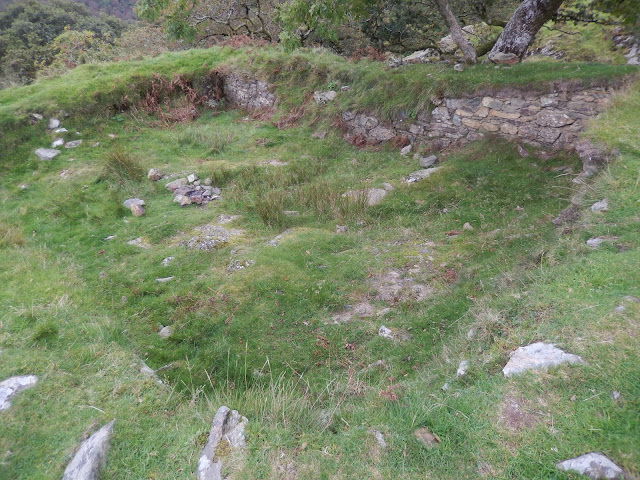Dinas Emrys (fortress of Ambrosius), near Beddgelert, Gwynedd, is the site of the famous confrontation between a young Merlin and the tyrant Vortigen, as told in Geoffrey of Monmouth’s The History of the Kings of Britain. This version is a modification of the story told in Nennius’s History of Britain, where the young child about to be sacrificed to stop Vortigen’s tower foundations from disappearing is named Ambrosius. The site is famous because of its association with Merlin and, as I did last year, I decided to pay my respects to the myth.
 |
| Part of the path through the oak woods to Dina Emrys |
 |
| View from the top of Dinas Emrys of Llyn Dinas and surrounding hills |
 |
| One of the ruins on top of Dinas Emrys |
 |
| View of dried out pool, with ‘offering platform’ on the right |
 |
| Another view of the famous pool, showing part of the ridge around the hollow |
 |
| Tower foundations and the small cave I meditated in last year |
 |
| Fortification ruins |
 |
| Another view from Dinas Emrys |
 |
| The men chainsawing and burning off |
 |
| Waterfall and pool from the path back from Dinas Emrys |
When I visited the site previously, I had no intention of using it for my novel. However, during this visit I came up with an idea of how to use the place, an idea that could possibly solve a problem I was having in the story. Such insights have happened unexpectedly at various sacred sites I’ve been visiting over the last few years and I am thankful for them.
 |
| Map of trails from Craflwyn (source, with detailed instructions) |


Hi Earl, that looks like quite a significant site with tower ruins and remnants of fortifications and buildings. Can you explain what the significance of the pool might have been? You point out an offering platform. That's a new concept to me. Would it have been a sacred pool dedicated to a god/ goddess?
Travel well
Hi Earl,
How frustrating to be in such a sacred place and to have the modern world butting in. There seem always to be these two levels in visiting places in UK. In my head I was in the 1930s visiting Stourbridge but modern shopping centres and tooting horns often broke into this spell. Good questions from Soni.
Cheers, Nadine.
Hi Nadine
While it is frustrating, the irony is that I wouldn't even be at such a site if not for the modern world in the shape of an aeroplane taking me from one continent to another. Such things do break the spell, but I suppose we just have to be more vigilant in blocking out what is not 'enchantment'.
Cheers, Earl
Hi Soni
In the medieval stories, when Ambrosius/Merlin is about to be sacrificed to stop Vortigen's walls from continually collapsing, he points out that the reason for the collapse is because of a pool in which two dragons, the Red Dragon of the British and the White Dragon of the Anglo-Saxons are fighting. Some digging proves this to be true, with the Red finally defeating the White, a prophecy of the British eventually repelling the Anglo-Saxons from the island.
The stone 'platform' at the edge of the pool does seem to me to be a place for offerings, especially as the Celts were known to toss objects into pools, as with the slave chains and other artefacts found at the famous Llyn Cerrig Bach on Anglesey (Ynys Mon). I'm not sure to what god or goddess or nature spirit such offerings might have been made on Dinas Emrys, but my sense of things is that it might have been to the Land Goddess herself, or at the very least the spirit of the mountain top.
I hope this helps.
Cheers, Earl